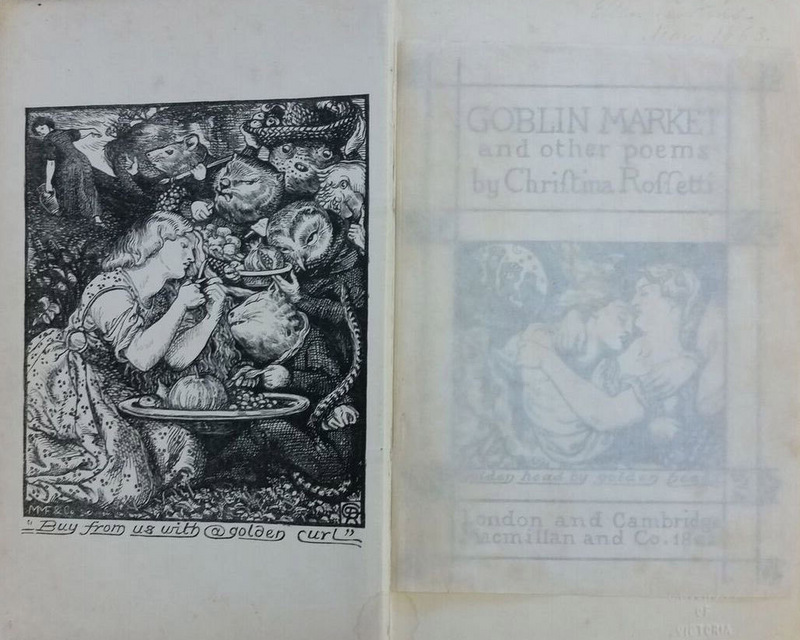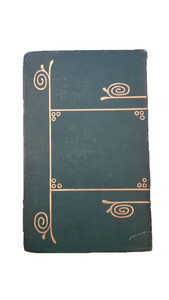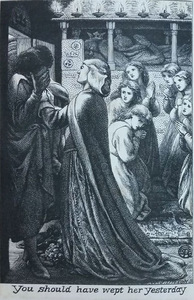Illustration & Bookbinding

Frontispiece Rossetti, Christina. Goblin Market, and Other Poems (with Two Designs by D.G. Rossetti).
Cambridge, UK: Cambridge University Press, 1862. (UVic Libraries, SC PR5237 G6).

Illustration: Goblin Market
The frontispiece woodblocks of Goblin Market (1862) depict the sisters featured in the story. They are rendered with a characteristically Rossetti style, specifically in the intense emotion and the flowing hair and garments of the ethereal figures. Rossetti’s illustrations do not simply refer to the text in which they appear; rather, they are part of a bigger program of art: the book as a whole.
Rossetti’s philosophy about the role of illustration was revealed in an 1855 letter to poet William Allingham, when he wrote, in reference to illustrations: “I have not begun even designing for them yet, but fancy […] those where one can allegorize on one’s own hook, without killing for oneself and everyone a distinct idea of the poet’s.” [1]
This passage makes apparent Rossetti’s desire to not just support the poet’s narrative, but to create an allegorical illustration that functions separately from the text as well. In this respect, Pre-Raphaelite illustrations go beyond depicting an episode from a poem, but rather function like subject paintings within a text. Illustration is not subservient to text and vice-versa. This philosophy furthers the idea of the Pre-Raphaelite book as an art object. Careful and conscientious craftsmanship is practiced in every aspect of production, and each element, though qualifiedly artistic in its own right, contributes to a unified art object (the book). Illustration is the most directly related art form to the traditional category of fine art, but less common elements contribute to the book as an integrated art object as well.
_____________________________________________________________________
1. Letter from D.G. Rossetti to William Allingham as quoted in D.S.R. Welland, The Pre-Raphaelites in Literature and Art (London, UK: George G. Harrap & Co. Ltd., 1953), 17.

Binding from Rossetti, Christina. The Prince’s Progress, and Other Poems (with Two Designs by D.G.
Rossetti). London, UK: Macmillan, 1866. (UVic Libraries, SC PR5237 P7).

Bookbinding: The Prince's Progress
Dante Gabriel Rossetti designed the illustrations and bindings from this 1866 edition of The Prince’s Progress, again written by Christina Rossetti. A book’s binding is the first element in the sensory experience of reading. Bindings point to the artistic nature of a book as a whole, and this can be seen in Rosetti's design. Rossetti disagreed with the gaudy ornamentation of many Victorian books, and thus attempted to refine the heavily ornamented book with his own bindings. In this publication, he employs a combination of minimalist motifs and contemporary technology, seen specifically in the gold stamping. The hand and machine work of this design ensured the perpetuation of Rossetti’s aesthetic through wider accessibility.
The gold design makes reference to clasps and nailheads on medieval books, and it is repeated on both the cover and back of the book [1]. Like illustration, this binding has an integrated role in the art of the book as a whole. In addition to the medieval allusion, the organic motifs reflect the theme of growth and change within the text. In this way, the binding becomes a part of the narrative.
_____________________________________________________________________
1. Rossetti, Christina, 1830-1894, “The Prince's Progress and other Poems,” Delaware Art Museum, Helen Farr Sloan Library & Archives Digital Exhibitions, accessed April 23, 2018, https://delartlibrary.omeka.net/items/show/42.

